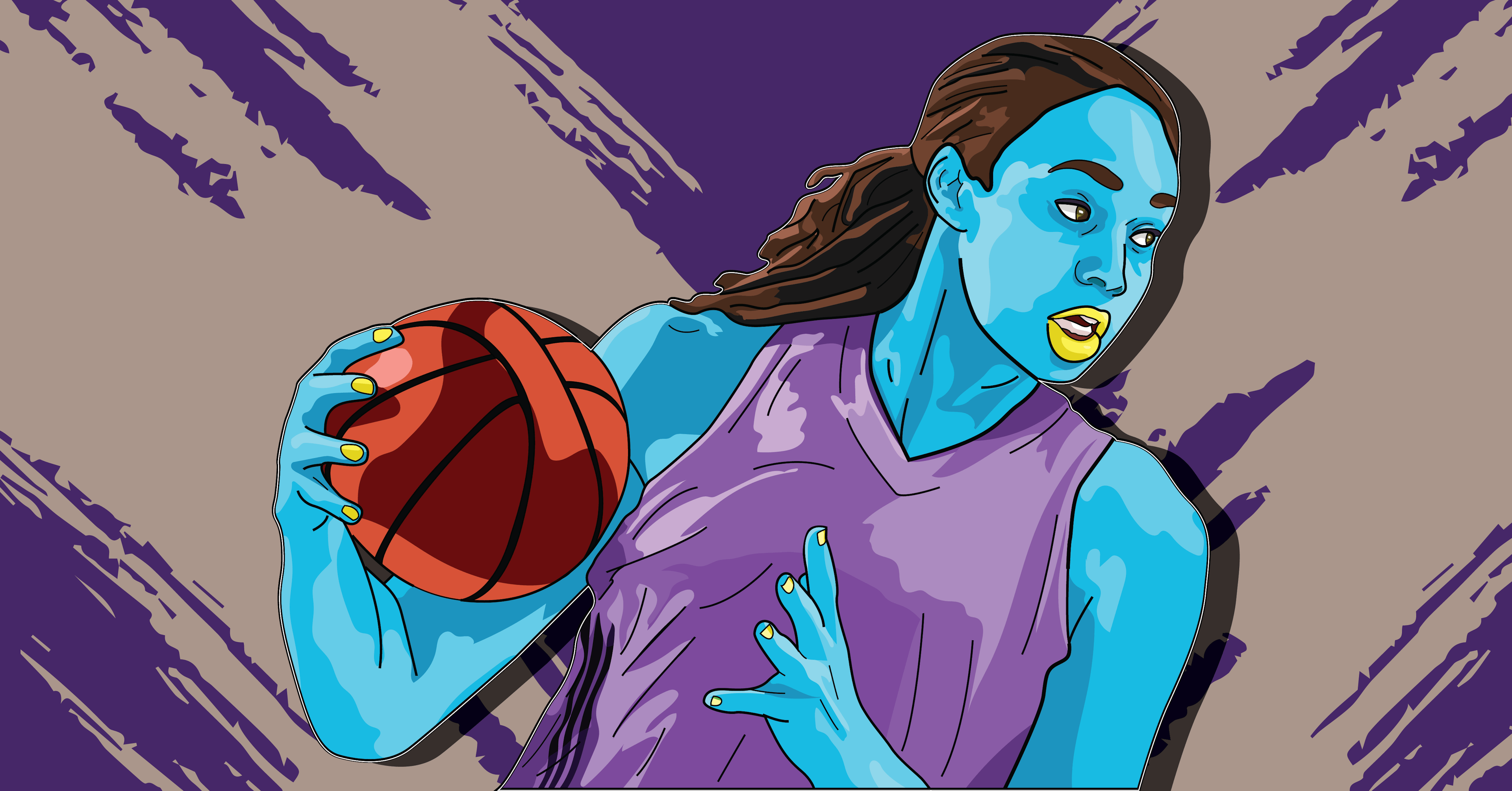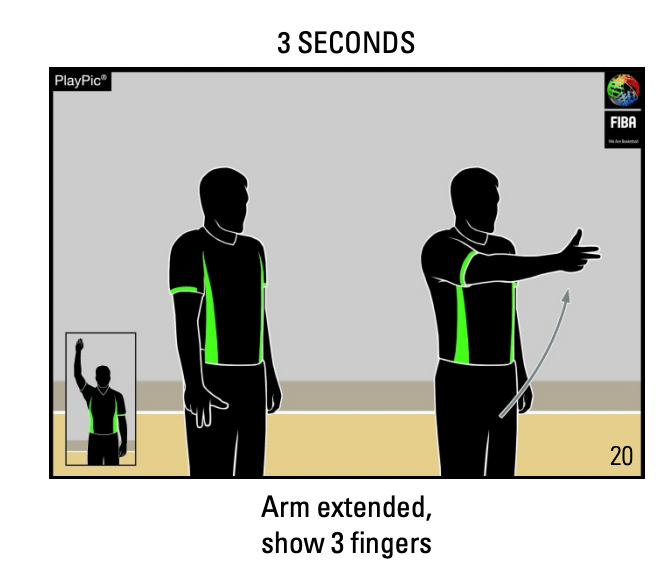
Are you getting the three-second rule called on your team in NBA2K or during games? If you’re confused what it’s all about we’ve got you covered. The 3-second violation in basketball was introduced in 1936 to help ensure the safety of hoopers.
The idea was to prevent bigs from sitting in the lane the whole game, shutting it down. And it’s succeeded in the NBA, as determined in a study by The Sport Journal which concluded: the three-second defensive rule has forced the big centers and shot blockers out of the lane.
So today we’ll take a look at what the 3-second violation is – including both the offensive and defensive violations. We’ll also provide some NBA and WNBA examples of legal and illegal play in the lane. Plus, we’ll give you some tips to avoid committing this simple mistake. Let’s get after it!
The 3-second rule says hoopers can’t sit in the lane (the 16-foot box that runs from the basket to the free throw line). Basically once a player is in the restricted area in the paint, they can only be there for 3 seconds. Then, they have to move both feet fully out of the paint. After that, they’re free to enter in again for another 3 seconds.
Here’s how article 26 of the FIBA rule book defines the 3-second rule: A player shall not remain in the opponents’ restricted area for more than 3 consecutive seconds while his team is in control of a live ball in the frontcourt and the game clock is running.
Allowances must be made for a player who:
To establish himself outside the restricted area, the player must place both feet on the floor outside the restricted area.
When a three-second violation has been committed the ref will extend their arm in front of them, and hold up their first three fingers starting from their thumb.

On offense the ball gets turned over to the other team. On defense it’s a technical foul and the other team gets one free throw attempt and possession of the ball from the sideline.
You get a 3-second violation by having any foot in the lane for more than 3 seconds in a row. Unless on that 3rd second you’re in the act of shooting. The count starts when your foot enters the area, and it ends when both feet are out. Lifting your feet in the air or jumping don’t count as a clean slate.
Yes, you can be called for a three-second violation if you have the ball but are not shooting.
There are two different types of three-second violations: the offensive and the defensive. Up next, you’ll learn about both.
The offensive 3-second rule is called on players who’s team has the ball, who stay in the lane posting up. The rule forces bigs to be more creative about where and how they call for the ball. When refs make the call, the defensive team gets the ball on the sideline.
Here’s how the NBA rule book defines the offensive three-second rule as follows (and the WNBA rule book says the same thing):
Here’s an example from the WNBA of legal play in the lane. Watch as an offensive big establishes position in the lane and then clears it with both feet before 3 seconds hits.
Here are two NBA examples of an offensive player in the lane illegally for more than three seconds:
1. In this situation the highlighted player is in the lane for more than three seconds, so a violation is called.
2. In this example the highlighted player is in the lane for more than three seconds and a violation is called, even though the player’s teammate is in the lane with the ball when the three-second count is reached. Because the ball is not in the highlighted players’ hands so he’s not in the act of shooting.
The defensive 3-second rule is called on players who’s team does not have the ball, who guard the lane if they are more than an arm’s length away from their man if their man is also in the lane – but they can be further if their man has the ball.
The rule forces the defense to pick when to clog the lane and makes players be creative about how they guard their big opponents. When refs make the call, the offensive team gets to take a free throw because it’s a technical foul, and then they get the ball on the sideline.
Both rule books define the defensive three-second rule as follows:
Here is an example from the WNBA of playing defense in the lane legally to avoid a 3-second violation. Notice how the defender is an arm’s length away from her player, and then also moves out of the lane. When the next defender enters the lane she is alone and not guarding the ball so her 3 second count begins, but before it ends she’s matched up within an arm’s length of an offensive player.
Check out this helpful NBA2K video discussing the requirements of the defense in order to be legal.
Yes the NBA rolled out the defensive 3-second violation in 2001. The defensive 3-second rule was established, limiting the amount of time a defensive player could stand in the lane when he was not closely guarding anyone. At the time, NBA owners approved a package of four rules changes, including the elimination of the long-standing ban on zone defenses. Shaquille O’Neal had a one-word response.”Stinks,” the Los Angeles Lakers star said. “I have a lot to say, but not now.” This rule also applies to college NCAA ball.
A few years later, the defensive 3-second rule was rolled out in the WNBA for the 2013 season and announced by Chief of Basketball Operations and Player Relations Renee Brown announced following a league Board of Governor’s Meeting. Under the new defensive three-second rule, a violation resulted in a technical foul being assessed if a defensive player violated the “actively guarding” guidelines.
In high school only the offensive 3 second rule applies. The hooper can’t be in the free-throw lane on offense for more than 3 seconds while their team is in control of the ball.
Two other time-based rules to know are the 10-second violation and the 8-second violation. Both of which involve getting the ball over the half court line (the time line).
The 10-second violation says the player needs to cross half court in 10 seconds after their team inbounds the ball. It was first introduced in 1933, as basketball’s first time restriction on possession of the ball. It even predated the shot clock by over two decades. Both FIBA and the NBA initially used the 10-second violation. But later updated it to just 8 seconds in 2000 and 2001 respectively.
In 2001 the NBA also rolled out the 8-second violation, by reducing from 10 seconds to 8 seconds the amount of time a team has to get the ball past midcourt. The eight-second rule was designed to make teams pressure the ball in the backcourt, which could lead to more open-court action and encourage teams to push the ball upcourt. The women’s college game and WNBA use the rule as well. Basically the goal was to make the game as fun to watch as possible.
Now you’re equipped to conquer the three second violation by being aware of it. Up next, learn more about what a carry is in basketball.